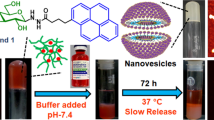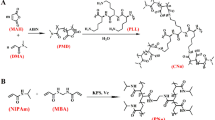Abstract
5-fluorouracil (5-FU) forms the basis of many chemotherapy regimens and is one of the most common preferred chemotherapeutic drugs. In this study, the synthesis of temperature and pH responsive hydrogels in the release of 5-fluorouracil (5-FU) was studied to prevent drug release during blood circulation and uncontrolled overdose drug concentration at the tumor site. In this regard, the synthesis of temperature sensitive polymer Poly(N-vinylcaprolactam) PNVCL, temperature and pH sensitive polymers P(NVCL-co-VIm) and P(NVCL-co-VIm)/PVP hydrogels was carried out by the free radical polymerization method. DSC analysis revealed that as a result of copolymerization of PNVCL with hydrophilic 1-vinylimidazole (VIm) and polyvinylpyrrolidone (PVP), the lower critical solution temperature (LCST) increased and was close to the human body temperature. In addition, it was concluded from pH sensitivity analysis that the swelling ratios of the hydrogels changed with the medium pH. Additionally, hydrogels swelled in the acidic medium but shrunk in the alkaline medium. Accordingly, 5-FU release was investigated in different temperatures (25 °C and 37 °C) and pH (pH 5.5 and 7.4) medium and approximately 96% drug release was reached at 37 °C and pH 7.4. Consequently, P(NVCL-co-VIm)/PVP hydrogels at different pH and temperature mediums could be beneficially utilized as a material with the potential to be used in targeted drug delivery systems.








Similar content being viewed by others
References
Hanahan D, Weinberg RA (2000) The Hallmarks of cancer review evolve progressively from normalcy via a series of pre. Cell 100:57–70
Zugazagoitia J, Guedes C, Ponce S et al (2016) Current challenges in cancer treatment. Clin Ther 38:1551–1566. https://doi.org/10.1016/j.clinthera.2016.03.026
Chabner BA, Roberts TG (2005) Chemotherapy and the war on cancer. Nat Rev Cancer 5:65–72. https://doi.org/10.1038/nrc1529
Mitchison DA (1979) Basic mechanisms of chemotherapy. Chest 76:771–780. https://doi.org/10.1378/chest.76.6.771
Wang Z, Mo H, He Z et al (2022) Extracellular vesicles as an emerging drug delivery system for cancer treatment: current strategies and recent advances. Biomed Pharmacother 153:113480. https://doi.org/10.1016/J.BIOPHA.2022.113480
Epstein JB, Thariat J, Bensadoun R-J et al (2012) Oral complications of cancer and cancer therapy. CA Cancer J Clin 62:400–422. https://doi.org/10.3322/CAAC.21157
Baudino T (2015) Targeted cancer therapy: the next generation of cancer treatment. Curr Drug Discov Technol 12:3–20. https://doi.org/10.2174/1570163812666150602144310
Giordano S, Petrelli A (2008) From single-to multi-target drugs in cancer therapy: when aspecificity becomes an advantage. Curr Med Chem 15:422–432. https://doi.org/10.2174/092986708783503212
Vasir JK, Labhasetwar V (2005) Targeted drug delivery in cancer therapy. Technol Cancer Res Treat 4:363–374. https://doi.org/10.1177/153303460500400405
Chang D, Ma Y, Xu X et al (2021) Stimuli-responsive polymeric nanoplatforms for cancer therapy. Front Bioeng Biotechnol 9:528. https://doi.org/10.3389/FBIOE.2021.707319/BIBTEX
Cheng W, Gu L, Ren W, Liu Y (2014) Stimuli-responsive polymers for anti-cancer drug delivery. Mater Sci Eng C 45:600–608. https://doi.org/10.1016/J.MSEC.2014.05.050
Gil ES, Hudson SM (2004) Stimuli-reponsive polymers and their bioconjugates. Prog Polym Sci 29:1173–1222. https://doi.org/10.1016/J.PROGPOLYMSCI.2004.08.003
Bajpai AK, Shukla SK, Bhanu S, Kankane S (2008) Responsive polymers in controlled drug delivery. Prog Polym Sci 33:1088–1118. https://doi.org/10.1016/j.progpolymsci.2008.07.005
Bawa P, Pillay V, Choonara YE, Du Toit LC (2009) Stimuli-responsive polymers and their applications in drug delivery. Biomed Mater. https://doi.org/10.1088/1748-6041/4/2/022001
Aguilar MR, San Román J (eds) (2019) Smart polymers and their applications. Woodhead publishing
Fogueri L, Singh S (2009) Smart polymers for controlled delivery of proteins and peptides: a review of patents. Recent Pat Drug Deliv Formul 3:40–48. https://doi.org/10.2174/187221109787158300
Park IK, Singha K, Arote RB et al (2010) PH-responsive polymers as gene carriers. Macromol Rapid Commun 31:1122–1133
Qureshi D, Nayak SK, Maji S et al (2019) Environment sensitive hydrogels for drug delivery applications. Eur Polym J 120:109220. https://doi.org/10.1016/j.eurpolymj.2019.109220
Schild HG (1992) Poly(N-isopropylacrylamide): experiment, theory and application. Prog Polym Sci 17:163–249. https://doi.org/10.1016/0079-6700(92)90023-R
Mohammed MN, Bin Yusoh K, Shariffuddin JHBH (2018) Poly(N-vinyl caprolactam) thermoresponsive polymer in novel drug delivery systems: a review. Mater Express 8:21–34. https://doi.org/10.1166/mex.2018.1406
Voycheva C, Slavkova M, Popova T et al (2022) Synthesis and characterization of PnVCL grafted agar with potential temperature-sensitive delivery of Doxorubicin. J Drug Deliv Sci Technol 76:103725. https://doi.org/10.1016/J.JDDST.2022.103725
Edson JA, Kwon YJ (2016) Design, challenge, and promise of stimuli-responsive nanoantibiotics. Nano Converg 3:1–13. https://doi.org/10.1186/S40580-016-0085-7
Sahebi H, Pourmortazavi SM, Zandavar H, Mirsadeghi S (2019) Chitosan grafted onto Fe3O4@poly(N-vinylcaprolactam) as a new sorbent for detecting Imatinib mesylate in biosamples using UPLC-MS/MS. Analyst 144:7336–7350. https://doi.org/10.1039/C9AN01654F
Schmaljohann D (2006) Thermo-and pH-responsive polymers in drug delivery. Adv Drug Deliv Rev 58:1655–1670
Kalhapure RS, Renukuntla J (2018) Thermo-and pH dual responsive polymeric micelles and nanoparticles. Chem Biol Interact 295:20–37. https://doi.org/10.1016/J.CBI.2018.07.016
Anderson EB, Long TE (2010) Imidazole- and imidazolium-containing polymers for biology and material science applications. Polymer 51:2447–2454
Zhang L, Peng XM, Damu GLV et al (2014) Comprehensive Review in current developments of imidazole-based medicinal chemistry. Med Res Rev 34:340–437. https://doi.org/10.1002/med.21290
Güngör A, Demir D, Bölgen N et al (2021) Dual stimuli-responsive chitosan grafted poly(NIPAM-co-AAc)/poly(vinyl alcohol) hydrogels for drug delivery applications. Int J Polym Mater Polym Biomater 70:810–819. https://doi.org/10.1080/00914037.2020.1765355
Işik B (2003) Thermoresponsive poly(N-isopropylacrylamide-co-N-vinylimidazole) hydrogels by redox polymerization. Adv Polym Technol 22:246–251. https://doi.org/10.1002/adv.10053
Yıldız B, Işık B, Kış M (2002) Synthesis and characterization of thermoresponsive isopropylacrylamide–acrylamide hydrogels. Eur Polym J 38(7):1343–1347. https://doi.org/10.1016/S0014-3057(01)00308-1
Işik B, Doǧantekin B (2005) Swelling behavior of poly(acrylamide-co-N-vinylimidazole) hydrogels under different environment conditions. J Appl Polym Sci 96:1783–1788. https://doi.org/10.1002/app.21608
Carneiro HCF, Tonon RV, Grosso CRF, Hubinger MD (2013) Encapsulation efficiency and oxidative stability of flaxseed oil microencapsulated by spray drying using different combinations of wall materials. J Food Eng 115:443–451. https://doi.org/10.1016/J.JFOODENG.2012.03.033
Güngör A, Özdemir T, Genç R (2023) Controlled 5-FU release from P(NIPAM-co-VIm)-g-PEG dual responsive hydrogels. ChemistrySelect. https://doi.org/10.1002/SLCT.202203522
Işik B (2004) Swelling behavior and determination of diffusion characteristics of acrylamide-acrylic acid hydrogels. J Appl Polym Sci 91:1289–1293. https://doi.org/10.1002/app.13270
Park H, Guo X, Temenoff JS et al (2009) Effect of swelling ratio of injectable hydrogel composites on chondrogenic differentiation of encapsulated rabbit marrow mesenchymal stem cells in vitro. Biomacromol 10:541–546. https://doi.org/10.1021/BM801197M/ASSET/IMAGES/LARGE/BM-2008-01197M_0006.JPEG
Pourjavadi A, Sadeghi M, Hashemi MM, Hosseinzadeh H (2006) Synthesis and absorbency of gelatin-graft-poly(sodium acrylate-co- acrylamide) superabsorbent hydrogel with saltand pH-responsiveness properties. E-Polymers. https://doi.org/10.1515/epoly.2006.6.1.728
Xiao XC (2007) Effect of the initiator on thermosensitive rate of poly(N-isopropylacrylamide) hydrogels. Express Polym Lett 1:232–235. https://doi.org/10.3144/expresspolymlett.2007.35
Khan S, Ranjha NM (2014) Effect of degree of cross-linking on swelling and on drug release of low viscous chitosan/poly(vinyl alcohol) hydrogels. Polym Bull 71:2133–2158. https://doi.org/10.1007/s00289-014-1178-2
Bennour S, Louzri F (2014) Study of swelling properties and thermal behavior of poly(N, N-dimethylacrylamide- co -maleic acid) based hydrogels. Adv Chem 2014:1–10. https://doi.org/10.1155/2014/147398
Chavda H, Patel C (2011) Effect of crosslinker concentration on characteristics of superporous hydrogel. Int J Pharm Investig 1:17. https://doi.org/10.4103/2230-973X.76724
Śliwa T, Jarzębski M, Andrzejewska E et al (2017) Uptake and controlled release of a dye from thermo-sensitive polymer P(NIPAM-co-Vim). React Funct Polym 115:102–108. https://doi.org/10.1016/j.reactfunctpolym.2017.04.003
Muratalin M, Luckham PF, Esimova A et al (2017) Study of N-isopropylacrylamide-based microgel particles as a potential drug delivery agents. Colloids Surf A Physicochem Eng Asp 532:8–17. https://doi.org/10.1016/j.colsurfa.2017.07.075
Kadajji VG, Betageri GV (2011) Water soluble polymers for pharmaceutical applications. Polymers 3:1972–2009. https://doi.org/10.3390/POLYM3041972
Liu L, Bai S, Yang H et al (2016) Controlled release from thermo-sensitive PNVCL-co-MAA electrospun nanofibers: the effects of hydrophilicity/hydrophobicity of a drug. Mater Sci Eng, C 67:581–589. https://doi.org/10.1016/J.MSEC.2016.05.083
Morfin-Gutierrez A, Sánchez-Orozco JL, García-Cerda LA et al (2021) Synthesis and characterization of poly(N-vinycaprolactam)-grafted gold nanoparticles by free radical polymerization for using as chemotherapeutic delivery system. Mater Chem Phys 266:124535. https://doi.org/10.1016/J.MATCHEMPHYS.2021.124535
Chi H, Chen P, Cao L et al (2016) Characterization and adsorptive properties of cross-linked poly (1-vinylimidazole)-iron (III) complex synthesized in supercritical carbon dioxide. E-Polymers 16:403–410. https://doi.org/10.1515/epoly-2016-0096
Fidalgo A, Ilharco LM (2001) The defect structure of sol–gel-derived silica/polytetrahydrofuran hybrid films by FTIR. J Non Cryst Solids 283:144–154. https://doi.org/10.1016/S0022-3093(01)00418-5
Alam AKMM, Beg MDH, Yunus RM et al (2021) Tailoring the dispersibility of non-covalent functionalized multi-walled carbon nanotube (MWCNT) nanosuspension using shellac (SL) bio-resin: structure-property relationship and cytotoxicity of shellac coated carbon nanotubes (SLCNTs). Colloid Interface Sci Commun 42:100395. https://doi.org/10.1016/J.COLCOM.2021.100395
Nouralishahi A, Khodadadi AA, Mortazavi Y et al (2014) Enhanced methanol electro-oxidation activity of Pt/MWCNTs electro-catalyst using manganese oxide deposited on MWCNTs. Electrochim Acta 147:192–200. https://doi.org/10.1016/J.ELECTACTA.2014.09.113
Alam AKMM, Beg MDH, Yunus RM et al (2016) Evolution of functionalized multi-walled carbon nanotubes by dendritic polymer coating and their anti-scavenging behavior during curing process. Mater Lett 167:58–60. https://doi.org/10.1016/J.MATLET.2015.12.130
Kozanoǧlu S, Özdemir T, Usanmaz A (2011) Polymerization of N-vinylcaprolactam and characterization of poly(N-vinylcaprolactam). J Macromol Sci Part A Pure Appl Chem 48:467–477. https://doi.org/10.1080/10601325.2011.573350
Pino-Ramos VH, Cedillo G, López-Barriguete E, Bucio E (2019) Comonomer effect: switching the lower critical solution temperature to upper critical solution temperature in thermo-pH sensitive binary graft copolymers. J Appl Polym Sci 136:1–9. https://doi.org/10.1002/app.48170
El Hoshoudy A (2015) Synthesis and characterization of polyacrylamide crosslinked copolymer for enhanced oil recovery and rock wettability alteration. Int J Oil Gas Coal Eng 3:43. https://doi.org/10.11648/j.ogce.20150304.11
Rahma A, Munir MM, Khairurrijal et al (2016) Intermolecular interactions and the release pattern of electrospun curcumin-polyvinyl(pyrrolidone) fiber. Biol Pharm Bull 39:163–173. https://doi.org/10.1248/bpb.b15-00391
Osman Z, Arof AK (2003) FTIR studies of chitosan acetate based polymer electrolytes. Electrochim Acta 48:993–999. https://doi.org/10.1016/S0013-4686(02)00812-5
Pasparakis G, Tsitsilianis C (2020) LCST polymers: thermoresponsive nanostructured assemblies towards bioapplications. Polymer 211:123146. https://doi.org/10.1016/J.POLYMER.2020.123146
Horta A, Molina MJ, Gómez-Antón MR, Piérola IF (2009) The pH inside a pH-sensitive gel swollen in aqueous salt solutions: poly(N-vinylimidazole). Macromolecules 42:1285–1292. https://doi.org/10.1021/MA802204B/ASSET/IMAGES/MA-2008-02204B_M026.GIF
Horta A, Piérola IF (2009) Poly(N-vinylimidazole) gels as insoluble buffers that neutralize acid solutions without dissolving. J Phys Chem B 113:4226–4231. https://doi.org/10.1021/JP809682D/ASSET/IMAGES/JP-2008-09682D_M024.GIF
Longley DB, Harkin DP, Johnston PG (2003) 5-Fluorouracil: mechanisms of action and clinical strategies. Nat Rev Cancer 3:330–338. https://doi.org/10.1038/nrc1074
Masaki M, Ogawa K, Kokufuta E (2009) Unusual behavior in light scattering experiments of poly(N-vinylimidazole) prepared by precipitation polymerization. Colloid Polym Sci 287:1405–1415. https://doi.org/10.1007/S00396-009-2104-2/FIGURES/8
Acknowledgements
This study was supported by the Mersin University Scientific Research Projects Department [Project number 2018-1-TP3-2842].
Author information
Authors and Affiliations
Corresponding author
Ethics declarations
Conflict of interest
The authors declare that they have no known competing financial interests or personal relationships that could have appeared to influence the work reported in this paper.
Additional information
Publisher's Note
Springer Nature remains neutral with regard to jurisdictional claims in published maps and institutional affiliations.
Rights and permissions
Springer Nature or its licensor (e.g. a society or other partner) holds exclusive rights to this article under a publishing agreement with the author(s) or other rightsholder(s); author self-archiving of the accepted manuscript version of this article is solely governed by the terms of such publishing agreement and applicable law.
About this article
Cite this article
Güngör, A., Özdemir, T. & Genç, R. Investigation of use in 5-FU release: Synthesis of temperature and pH responsive P(NVCL-co-VIm)/PVP hydrogels. Polym. Bull. 81, 2091–2109 (2024). https://doi.org/10.1007/s00289-023-04806-5
Received:
Revised:
Accepted:
Published:
Issue Date:
DOI: https://doi.org/10.1007/s00289-023-04806-5




